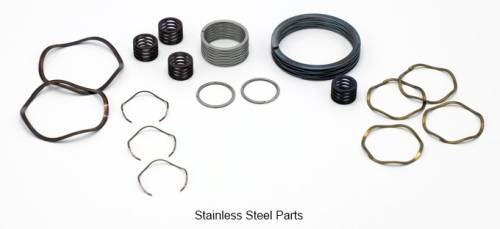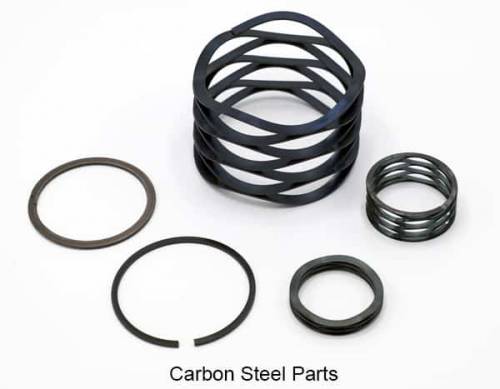Smalley Colour variations in Materials for Retaining Rings and Wave Springs
Smalley Colour variations
- Carbon steel
- Stainless Steel (302, 316, 17-7)
- A-286
- Inconel (X-750, 718, 625, etc.)
- Elgiloy®
- MP35N®
- Beryllium Copper
Operating environment must be considered when choosing materials; because temperature, atmosphere, and presence of contaminants will heavily influence material choice. In order to ensure that our parts function properly when operating in these different environments, a number of processes are often used.

Post-Production Procedures
Heat treatment is a process that enhances the material properties of the metal, such as tensile strength and/or hardness. Open air heat treatment is the standard practice at Smalley, and in this type of heat treatment, there is no special control to the atmosphere. This may cause heat scale to form, which can alter the colour of the metal. Atmosphere controlled heat treats may be used in some cases that reduce the colour variation after heat treat.
Stress relieving is a heating process that removes internal stresses created by the coiling process. Without stress relief, the diameter of the part can open up, which is not detrimental for internal rings which cling on the outside diameter, but for external rings, it is problematic since it could reduce the cling.
Passivation is performed on stainless steels using an acid based solution to dissolve or loosen iron particles and other substances that are embedded on the surface of the material. This allows for the formation of a better oxide layer to enhance the corrosion resistance of stainless steels.

Colour Change
All of these methods can cause a colour change in metals. Colour variations are strongly influenced by the environment, temperature, and length of time exposed to these temperatures. Below are some typical colour variations:
- 17-7 stainless: blue, brown, or grey
- A-286: blue or grey
- Carbon steel: blue, black, or grey
Steel is commonly thought of as silver or grey in colour, so it can come as a shock when steel rings or springs arrive in a different colour. These colour changes do not have an effect on the fit, form, or function of the parts. These changes are a side-effect from improving the properties of the material to make them more effective in the application.
Colour variation in materials
The most important thing to remember is, once again, that these colour changes will not affect your part in any way relating to its performance. from the start of the design process, you need to consider exactly what is important for your ring or spring. If a part is visible and the colour is critical to your application’s needs, we offer a number of different solutions like vacuum heat treatment, passivation, special finish, polishing or plating. It is important to consider the added time and cost of adding these supplementary manufacturing processes, though; if the part cannot be seen, it is likely to be an unnecessary expenditure.


